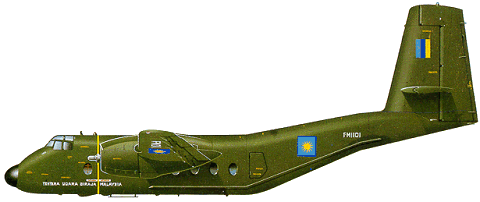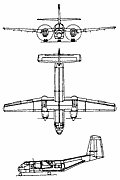|
| The decision to build the de Havilland Canada DHC-4 Caribou was taken in 1956, the object being to develop an aircraft combining the load-carrying capability of the Douglas DC-3 with the STOL performance of the Beaver and Otter. The Canadian army placed an order for two and the US Army followed with five, the US Secretary of Defense waiving a restriction which limited the US Army to fixed-wing aircraft with an empty weight less than 2268kg.
The prototype flew in July 1958, its high wing having a characteristic centre-section with marked anhedral. The rear door was designed as a ramp for items weighing up to 3048kg. In the trooping role up to 32 soldiers could be carried. The Caribou served with the RCAF as the CC-108 and with the US Army as the AC-1 (1962 designation CV-2A). As a result of its evaluation of the first five aircraft the US Army adopted the Caribou as standard equipment and placed orders for 159.
The second batch of aircraft was designated CV-2B. Following tension on the border between China and India, the US Army handed over two Caribous to the Indian Air Force in early 1963. In January 1967 the 134 Caribous still in service with the US Army were transferred to US Air Force charge as C-7A and C-7B transports. The aircraft was a general sales success and examples flew not only with air forces throughout the world, but also with civil operators. In Canadian service the Caribou was replaced by the DHC-5 Buffalo and surplus examples were sold to a number of nations including Colombia, Oman and Tanzania. Many of the Canadian aircraft had been loaned to the United Nations, seeing extensive international service. Production ended in 1973. The DHC-4A model supplanted the DHC-4 on the production line from aircraft no. 24: the two models are very similar apart from the later model's increase in weight, maximum take-off weight of the DHC-4 being 11793kg. Total production was 307.

| MODEL | DHC-4A Caribou |
| CREW | 2 |
| PASSENGERS | 32 |
| ENGINE | 2 x Pratt & Whitney R-2000-7M Twin Wasp, 1081kW |
| WEIGHTS |
| Take-off weight | 12927 kg | 28499 lb |
| Empty weight | 8283 kg | 18261 lb |
| DIMENSIONS |
| Wingspan | 29.15 m | 96 ft 8 in |
| Length | 22.12 m | 73 ft 7 in |
| Height | 9.68 m | 32 ft 9 in |
| Wing area | 84.72 m2 | 911.92 sq ft |
| PERFORMANCE |
| Max. speed | 348 km/h | 216 mph |
| Cruise speed | 293 km/h | 182 mph |
| Ceiling | 7560 m | 24800 ft |
| Range w/max payload | 389 km | 242 miles |
 | A three-view drawing (592 x 887) |
| B. Farmer, e-mail, 24.09.2009 18:05 flew as flight engineer on the bou in viet nam. Was a great aircraft. She did what was asked of her. Noisy or not loved the ole girl. reply | | agustin f jose, e-mail, 16.08.2009 19:57 hi just wondering if you could send me details on the a /c performance.we have one in the philippines and we're taking it to djibouti,africa soon (i wonder how long will it take us to reach africa) to do the djibouti-dubai run...thank you reply | | ismail, e-mail, 04.11.2008 05:45 The caribou is very much liked by the RMAF personnel due to its ruggedness as well as its awesome STOL capabilities especially when operating at very short remote airstrips during the 60s to the 70s.In the mid 90s the Caribou still flying and its last duty were cloud seeding..although retired about a decade ago its distinct sound from its radial engine can never be forgotten..piston engine rules! reply | | T.Koniarz, e-mail, 17.05.2008 17:50 Yeah, she,s my baby.My year in Nam was no Maytag serviceman job. reply |
|
| | Dennis Toaspern, e-mail, 30.04.2008 19:08 If the original versions of this aircraft had been fitted with PT-6 turboprop engines, it would be the twin-engine equivalent of the C-130 Hercules. The Buffalo came along just in time to be caught in inter-service politics and was never adopted. For the last 9 years, I've been involved with 62-4149 and, except for a few engine-related issues, it does what it was designed to do and does it well. Turbo-props are efficient and quiet--radials have soul! reply |
| G Beale, e-mail, 02.04.2008 03:35 Flew outa Nam in one back in 66. Who cared if it was noisy or you sat on oil barrels, you were leaving, even if not on a jet plane. Great bush plane there. reply | | Andrea, e-mail, 14.06.2007 20:49 Good morning...
We have here in Costa Rica an De Havilland Caribuo model DHC-4A, this aircraft has like 10 years no flights and we wanna put it again to flights, we wonder if you have and if you can send us a SBīs, ADīs list applicables to this aircraft. Engine Model: Pratt & Whitney R-2000-7M2 reply | | S.Pragasam, e-mail, 24.05.2007 15:07 The Caribou used by the RMAF is tough versatile workhorse.
But it is very noisy using a piston driven engine. reply |
|
Do you have any comments?
|
| 
COMPANY
PROFILE
All the World's Rotorcraft
|








 Dennis Toaspern
Dennis Toaspern
20
reply